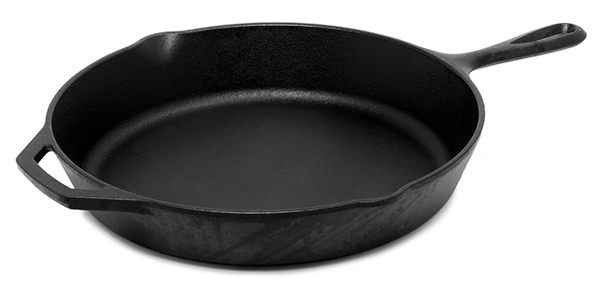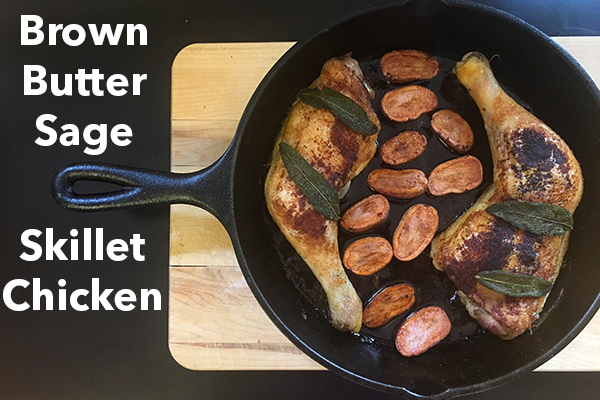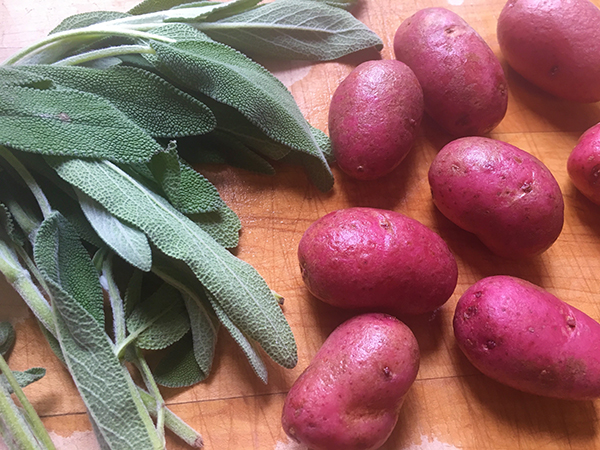Cast iron skillets seem to intimidate many of us. With all the do’s and don’ts, they may seem like a lot of work, but once you get the hang of how to take care of them, they’re a breeze and a great safe cookware option.
Cleaning Your Cast Iron Skillet
The cleaning of your cast iron skillet is super simple, but a little different than how you would clean other types of cookware.
The best time to clean your skillet is right after you are done using it, while it’s still warm (but not so hot that you will burn yourself). You want to scrub off the food bits without destroying the seasoning on the pan. This is why steel wool and soap are usually discouraged, since they can remove some or all of the layers of seasoning (depending on how old your pan is). Running the pan under hot water while gently scrubbing is the best and easiest way I have found to clean my cast iron skillets.
After you clean off the stuck-on bits then make sure you dry the skillet completely, I do this by putting it back on the warm burner or back in the warm oven, whichever I just finished using. If you let it soak in the sink or put it away wet, you run the risk of rust forming on your skillet. Once your skillet is bone dry, you can re-season it, by rubbing lard or oil on your skillet. You may not need to do this every time, but it can be helpful to maintain the seasoning. You can also put it back in the warm oven after adding the oil. I don’t do this every time, but it can be helpful to “seal” in the seasoning.
Caring for cast iron skillets doesn't need to be complicated, just follow these 6 simple steps! #saslife Click To TweetNote: There are several different methods to caring for your cast iron skillets. This is what I have found to work for me and my skillets. I use pasture raised lard more than any other type of oil or fat when seasoning a cast iron skillet. There are many opinions out there about what is best. Check out THIS post about using flaxseed oil (based on THIS post). I haven’t tried it, but it sounds interesting!
Remember these steps:
- Clean skillet immediately after use, while it’s still warm.
- DO NOT soak or leave skillet in the sink, this can lead to rust!
- Using a scrub brush or sponge (no steel wool) and NO SOAP, run skillet under hot water scrubbing stuck on bits.
- Place skillet back on the hot stove or in the warm oven to dry completely.
- Once dry, add oil or lard to the skillet.
- Spread evenly with paper towel (you can use your fingers if skillet isn’t too hot- be careful!). Wipe off any excess.
Brown Butter Sage Skillet Chicken
Adapted from: Howtodothisandthat.com
Makes 2-3 Servings
Ingredients
2-3 chicken thighs or 2 chicken leg quarters
6-8 baby potatoes halved
1 teaspoon garlic powder
1 teaspoon onion powder
¼ tsp sea salt
¼ tsp pepper
2 tablespoons butter
4 sage leaves or ½ tsp dried sage
Instructions
- Preheat the oven to 425ºF.
- Combine garlic powder, onion powder, salt and pepper in a small bowl and mix well. Rub or sprinkle evenly over chicken.
- Heat 9’ cast iron skillet over medium heat.
- Add butter, and when melted add chicken, skin side down. Sear until skin is golden brown. Flip chicken, add potatoes and sage.
- Place skillet in the oven and cook until chicken is done (165ºF)– about 10-15 minutes.





2 Comments
I will stop using dish liquid on my cast iron skillet. I like the video's musical accompaniment.
Glad you found the blog helpful, and entertaining. 🙂